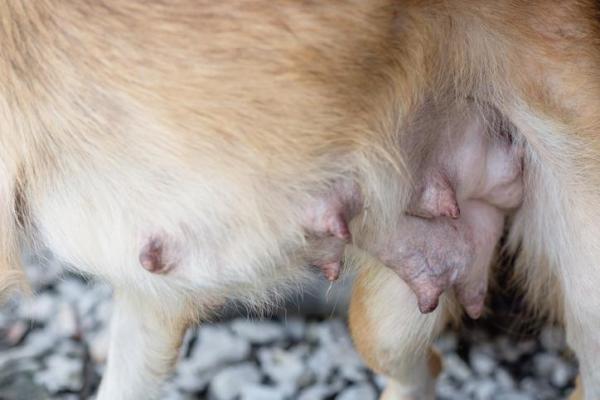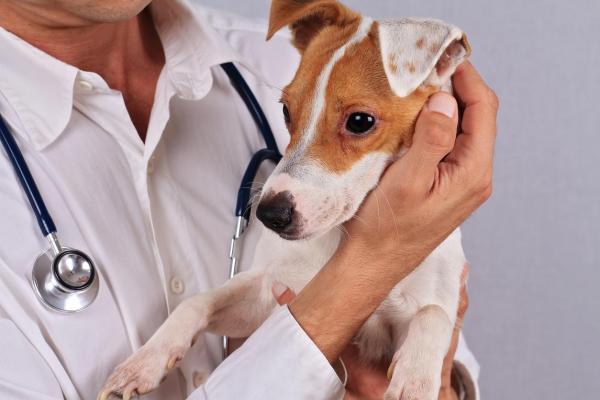Breast Cancer in Dogs - Symptoms and Treatment



See files for Dogs
If you see a lump on your dog's nipple area, it's important to consider the potential of breast cancer in dogs. There are other symptoms of canine mammary cancer, but a lump is one of the most common. This does not mean a lump in the nipple area will provide diagnosis of cancer. This is something which needs to be confirmed by your veterinarian. They will be able to determine the cause of the symptoms and provide the best course of action in terms of treatment.
At AnimalWised, we help you both how to detect and what you can expect in this situation by looking at the symptoms and treatment of breast cancer in dogs. We also explain the bets methods of breast cancer prevention in dogs.
What is breast cancer in dogs?
Cancer is the abnormal, continuous and rapid proliferation of cells in the body's tissues. As its name indicates, the affect tissue with breast cancer in dogs is their mammary glands. Almost all cells in the body of an organism die and are replaced throughout the life of the individual. If a mutation occurs in the mechanisms that govern this cell division, very rapidly growing cells will form. It is these that result in masses capable of displacing healthy cells.
Cancer cells do not fulfill the functions of cells. If the cancer spreads, it will invade the area or organ where it originates. Over time, this causes damage that will lead to the death of the dog. In young animals, their growth is usually faster. In older animals, the rate of cell regeneration is usually slower. However, this depends on the aggressiveness of the type of cancer in the dog.
Causes of breast cancer in dogs
We do not know the exact cause of many cancers. There are genes that suppress cancer cells, as well as those that inhibit their function. These cells are also influenced by external factors such as diet, stress or the environment. In this way, we can say cancer is a phenomenon where genetics and the environment interact.
Although we often don't know the cause of breast cancer in dogs, there are carcinogens in the environment which increase the chances of a cancer developing. Such carcinogenic environmental elements include ultraviolet light, x-rays, nuclear radiation, certain chemicals, tobacco and various others.
Tumors caused by cancer are types of neoplasms and can be benign or malignant. The former usually grow slowly, without invading or destroying the surrounding tissues. They do not usually spread to other parts of the body. If possible, they are removed with surgery. Malignant tumors do invade adjacent tissues and grow exponentially. These tumor cells can enter the circulatory system and move from the primary tumor to other parts of the body. This process is called metastasis.

Symptoms of breast cancer in dogs
Dogs have about ten mammary glands, distributed in two symmetrical chains on each side of the body. These run from the the chest to the groin. Unfortunately, tumors in these glands are very common and most occur in dogs over six years of age. This incidence is even higher in dogs over 10 years of age. These different types of tumors in dogs may be benign or malignant.
This type of cancer is largely hormone-dependent. This means its appearance and development are linked to hormones, mainly estrogen and progesterone. These are involved in the reproductive cycle of the dog and for which there are receptors in the mammary tissue.
As caregivers, the main symptom which indicates breast cancer in dogs is the presence of a lump on the mammary tissue. This can be difficult to see, especially in longhaired dogs, but it can be felt relatively easily. This mass will be of variable size and with a more or less defined contour. It can be either attached to the skin or free from it. Sometimes the skin ulcerates and we can see an open wound. Bloody discharge from the dog's nipple is also possible.
Since female hormones often influence the development of breast cancer, we may think only females can be affected. Although female dogs are more likely to develop this disease, you might see a lump on a male dog's nipple which indicates breast cancer. This is less likely than in females and mammary tumors are the most common type of tumor in reproductively intact female dogs[1].
Inflammation of the mammary tissue does not necessarily mean cancer is present. Learn about other reasons why a dog has swollen breasts in our related article.
Diagnosis of breast cancer in dogs
Once any possible symptom of breast cancer in dogs is detected, we must seek veterinary attention immediately. After palpation, a veterinarian can confirm the diagnosis. This will differentiate from other possible causes such as mastitis in dogs. As we will see, the treatment will often involve surgical extraction of the mass, but the vet will need to determine the type of lump.
The removed material must be sent for analysis with a test known as a biopsy. It will be the specialized histopathological laboratory that will be responsible for determining the exact type of cancer cells present. This diagnostic test will also be able to tell us if the tumor is benign or malignant. In the latter case, it will help determine the degree of virulence and whether it has metastasized.
Diagnostic tests for breast cancer in dogs will help determine the prognosis. If the cancer is malignant, they can help to determine the life expectancy of the dog with breast cancer.
Treatment of breast cancer in dogs
The effectiveness of breast cancer treatment in dogs will depend on early diagnosis. As we have stated, surgical removal will be the most common treatment. This is not commonly used in cases in which a terminal disease occurs or the presence of metastasis is confirmed. Before entering the operating room, the veterinarian will perform an x-ray to determine location, size and other important factors relating to the tumor.
The appearance of metastases in the lungs is relatively common with breast cancer in dogs. This can result in additional symptoms such as breathing difficulties in the dog. An ultrasound and/or blood test will likely be carried out.
During breast tumor removal surgery, the tumor itself and some adjacent healthy tissue will be removed. The extent of the extraction will depend on the size and location of the tumor. This means sometimes not much more than the tumor itself will be removed. On other occasions, the entire breast might be excised. The prognosis will be more unfavorable the larger the tumor and the greater its aggressiveness.
Since it is a hormone-mediated cancer, an ovariohysterectomy may be performed for sexually intact females. This is a process commonly known as spaying which removes the ovaries and uterus of the dog. It will help control their hormone production and reduce the risk of the cancer returning.
If our dog has metastases, surgical intervention is not recommended. In some cases, the mass can be removed if it can improve the dog's quality of life. In addition to surgical removal, it may also be necessary to administer chemotherapy. This can help prevent and control metastasis.
The postoperative period will be similar to any other surgery. We must ensure our dog does not tear out the stitches. We also need to monitor the dog's stitches for any signs of infection. The wound must be kept clean and protected, often with the use of an e-collar dog dogs. We should avoid sudden movements and games that can encourage the opening of the wound. Antibiotic therapy and analgesia will be administered to avoid bacterial infection and manage pain, respectively.

Breast cancer prevention in dogs
Since the cause of breast cancer in dogs is related to the production of sexual hormones, certain preventive measures can be taken to reduce the chances of its development in your dog. Early sterilization of our dog is one of the most effective prevention methods. With the removal of the uterus and ovaries, the dog is unable to produce the same level of sex hormones, drastically reducing the likelihood of breast cancer.
Performing the spay procedure is most effective when it is carried out before the dog's first heat period. It reduces the risk of breast cancer significantly[2]. From the second heat cycle onwards, the percentage of protection provided by sterilization decreases. If we adopt an adult dog, we must operate on her as soon as possible, preferably when she is not in heat due to the greater risk of hemorrhaging.
Among the preventive measures, early detection also stands out. It is worth examining our dog's breasts periodically and seeking prompt veterinary attention for any presence of masses, redness, inflammation, discharge or pain.
From the age of six, a monthly examination can be done at home in unsterilized or late-sterilized dogs. We must also attend routine veterinary check-ups for these dogs. Dogs over 7 years old should undergo an annual physical exam since palpation of the mammary glands can detect the presence of cancer.
Finally, you should know that the use of products to control the dog's heat (progestins) favors the appearance of breast cancer. In addition, dogs that have suffered phantom pregnancy (psychological pregnancies) are also more likely to develop breast cancer. All of these data reiterate the need for early sterilization to ensure that our dog has the best quality of life and a longer life expectancy.

This article is purely informative. AnimalWised does not have the authority to prescribe any veterinary treatment or create a diagnosis. We invite you to take your pet to the veterinarian if they are suffering from any condition or pain.
If you want to read similar articles to Breast Cancer in Dogs - Symptoms and Treatment, we recommend you visit our Other health problems category.
1. Vascellari, M., Capello, K., Carminato, A., Zanardello, C., Baioni, E., & Mutinelli, F. (2016). Incidence of mammary tumors in the canine population living in the Veneto region (Northeastern Italy): Risk factors and similarities to human breast cancer. Preventive veterinary medicine, 126, 183–189. https://doi.org/10.1016/j.prevetmed.2016.02.008
2. Beaudu-Lange, C., Larrat, S., Lange, E., Lecoq, K., & Nguyen, F. (2021). Prevalence of Reproductive Disorders including Mammary Tumors and Associated Mortality in Female Dogs. Veterinary sciences, 8(9), 184.
https://doi.org/10.3390/vetsci8090184







